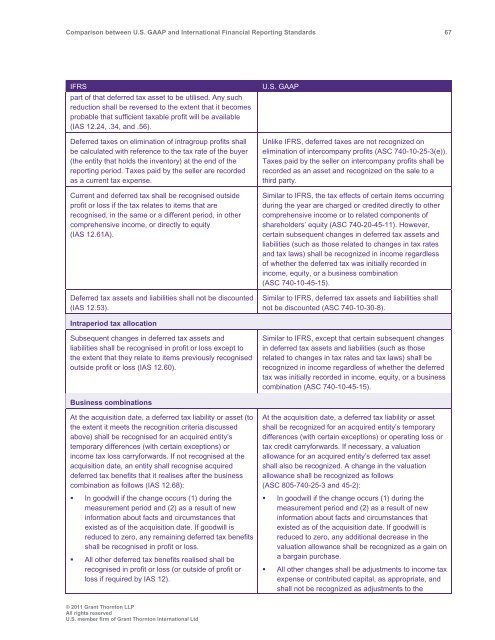Comparison between U.S. GAAP and International ... - Grant Thornton
Comparison between U.S. GAAP and International ... - Grant Thornton
Comparison between U.S. GAAP and International ... - Grant Thornton
You also want an ePaper? Increase the reach of your titles
YUMPU automatically turns print PDFs into web optimized ePapers that Google loves.
<strong>Comparison</strong> <strong>between</strong> U.S. <strong>GAAP</strong> <strong>and</strong> <strong>International</strong> Financial Reporting St<strong>and</strong>ards 67<br />
IFRS<br />
part of that deferred tax asset to be utilised. Any such<br />
reduction shall be reversed to the extent that it becomes<br />
probable that sufficient taxable profit will be available<br />
(IAS 12.24, .34, <strong>and</strong> .56).<br />
Deferred taxes on elimination of intragroup profits shall<br />
be calculated with reference to the tax rate of the buyer<br />
(the entity that holds the inventory) at the end of the<br />
reporting period. Taxes paid by the seller are recorded<br />
as a current tax expense.<br />
Current <strong>and</strong> deferred tax shall be recognised outside<br />
profit or loss if the tax relates to items that are<br />
recognised, in the same or a different period, in other<br />
comprehensive income, or directly to equity<br />
(IAS 12.61A).<br />
Deferred tax assets <strong>and</strong> liabilities shall not be discounted<br />
(IAS 12.53).<br />
U.S. <strong>GAAP</strong><br />
Unlike IFRS, deferred taxes are not recognized on<br />
elimination of intercompany profits (ASC 740-10-25-3(e)).<br />
Taxes paid by the seller on intercompany profits shall be<br />
recorded as an asset <strong>and</strong> recognized on the sale to a<br />
third party.<br />
Similar to IFRS, the tax effects of certain items occurring<br />
during the year are charged or credited directly to other<br />
comprehensive income or to related components of<br />
shareholders’ equity (ASC 740-20-45-11). However,<br />
certain subsequent changes in deferred tax assets <strong>and</strong><br />
liabilities (such as those related to changes in tax rates<br />
<strong>and</strong> tax laws) shall be recognized in income regardless<br />
of whether the deferred tax was initially recorded in<br />
income, equity, or a business combination<br />
(ASC 740-10-45-15).<br />
Similar to IFRS, deferred tax assets <strong>and</strong> liabilities shall<br />
not be discounted (ASC 740-10-30-8).<br />
Intraperiod tax allocation<br />
Subsequent changes in deferred tax assets <strong>and</strong><br />
liabilities shall be recognised in profit or loss except to<br />
the extent that they relate to items previously recognised<br />
outside profit or loss (IAS 12.60).<br />
Similar to IFRS, except that certain subsequent changes<br />
in deferred tax assets <strong>and</strong> liabilities (such as those<br />
related to changes in tax rates <strong>and</strong> tax laws) shall be<br />
recognized in income regardless of whether the deferred<br />
tax was initially recorded in income, equity, or a business<br />
combination (ASC 740-10-45-15).<br />
Business combinations<br />
At the acquisition date, a deferred tax liability or asset (to<br />
the extent it meets the recognition criteria discussed<br />
above) shall be recognised for an acquired entity’s<br />
temporary differences (with certain exceptions) or<br />
income tax loss carryforwards. If not recognised at the<br />
acquisition date, an entity shall recognise acquired<br />
deferred tax benefits that it realises after the business<br />
combination as follows (IAS 12.68):<br />
• In goodwill if the change occurs (1) during the<br />
measurement period <strong>and</strong> (2) as a result of new<br />
information about facts <strong>and</strong> circumstances that<br />
existed as of the acquisition date. If goodwill is<br />
reduced to zero, any remaining deferred tax benefits<br />
shall be recognised in profit or loss.<br />
• All other deferred tax benefits realised shall be<br />
recognised in profit or loss (or outside of profit or<br />
loss if required by IAS 12).<br />
At the acquisition date, a deferred tax liability or asset<br />
shall be recognized for an acquired entity’s temporary<br />
differences (with certain exceptions) or operating loss or<br />
tax credit carryforwards. If necessary, a valuation<br />
allowance for an acquired entity’s deferred tax asset<br />
shall also be recognized. A change in the valuation<br />
allowance shall be recognized as follows<br />
(ASC 805-740-25-3 <strong>and</strong> 45-2):<br />
• In goodwill if the change occurs (1) during the<br />
measurement period <strong>and</strong> (2) as a result of new<br />
information about facts <strong>and</strong> circumstances that<br />
existed as of the acquisition date. If goodwill is<br />
reduced to zero, any additional decrease in the<br />
valuation allowance shall be recognized as a gain on<br />
a bargain purchase.<br />
• All other changes shall be adjustments to income tax<br />
expense or contributed capital, as appropriate, <strong>and</strong><br />
shall not be recognized as adjustments to the<br />
© 2011 <strong>Grant</strong> <strong>Thornton</strong> LLP<br />
All rights reserved<br />
U.S. member firm of <strong>Grant</strong> <strong>Thornton</strong> <strong>International</strong> Ltd
















